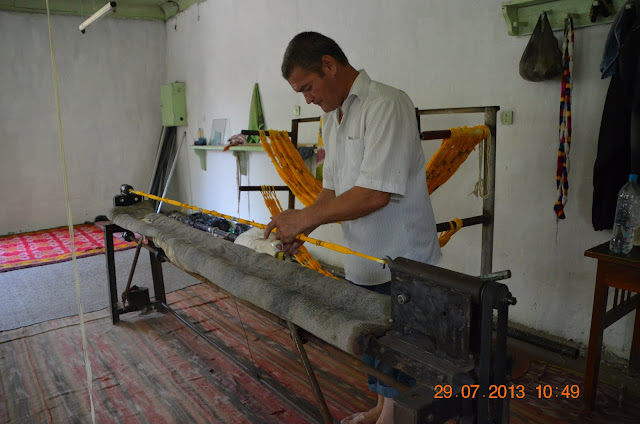Location: Margilan, 20km north of Fergana city, Fergana Valley, Uzbekistan
Date: 29 July 2013
Uzbekistan is the third largest silk producer in the world after China and India, though the volume produced still pales in comparison to the latter two countries. Nevertheless, Uzbek silk have in the past travelled along the old Silk Road to various countries such as China, India, Iran etc. Uzbek silk with its signature patterns are known as 'ikat' derived from the malay word meaning tied.
Today we visited a Silk Factory in Margilan that still preserved the old ways of producing silk.
Silk caterpillars feed on mulberry leaves and take a few days to spin the cocoon completely around its body. These cocoons are then immediately collected for processing into silk threads. They are not left to grow to the pupae stage to ensure than once unravelled, each cocoon is able to produce a single continuous strand of silk thread. This continous strand ensures stronger cloth once woven.

Once sorted, the cocoons are placed in boiling water to kill the caterpillar, soften the cocoons and to make the end of the silk strands more visible.

A single cocoon can yield a single strand / filament up to 1,000 metres long. Each strands are very fine and a few are spun together to make silk threads.


Once sorted, the cocoons are placed in boiling water to kill the caterpillar, soften the cocoons and to make the end of the silk strands more visible.

A single cocoon can yield a single strand / filament up to 1,000 metres long. Each strands are very fine and a few are spun together to make silk threads.

Natural shine of raw silk.
Raw silk still contain sericin (the glue that keeps the cocoon solid and strong) that protects the silk strands as it is processed into threads.

The sericin is removed entirely by washing the silk threads in soap and warm water, leaving behind lighter and softer threads.
These silk threads are then dyed to the preferred colour.
The silks threads are placed on looms and weaved.
The weaver takes about 1 month to complete a roll of silk cloth, weaving about 1 metre of cloth per day.
The weaver takes about 1 month to complete a roll of silk cloth, weaving about 1 metre of cloth per day.



A single weaver will need about a year to complete a large carpet. A smaller carpet will take up to four months. As these are hand made, the weaver completes about 2-3 cms a day.

These days weaving is done by machines and rolls can be completed at a much faster pace.
The majority of weavers are women. This particular factory employs about 125 staff working 5 days a week.
Cocoon processing section

A very old mulberry tree. The mulberry silkworm feeds on the mulberry leaves.
They prefer the white mulberry leaves, but do eat the leaves of other mulberry trees as well.
After our visit to the Silk Factory, we left Margilan around noon and drove north to Turakurgon before heading west to Chust.
Midday sun is just too much for these two guys ...need a face wash to refresh...
Arriving at Turakurgon, nearly 2pm..
Lots of grapes grown on the perimeter walls near Turakurgon
Beautiful bunches of juicy grapes...ready to be picked...











No comments:
Post a Comment